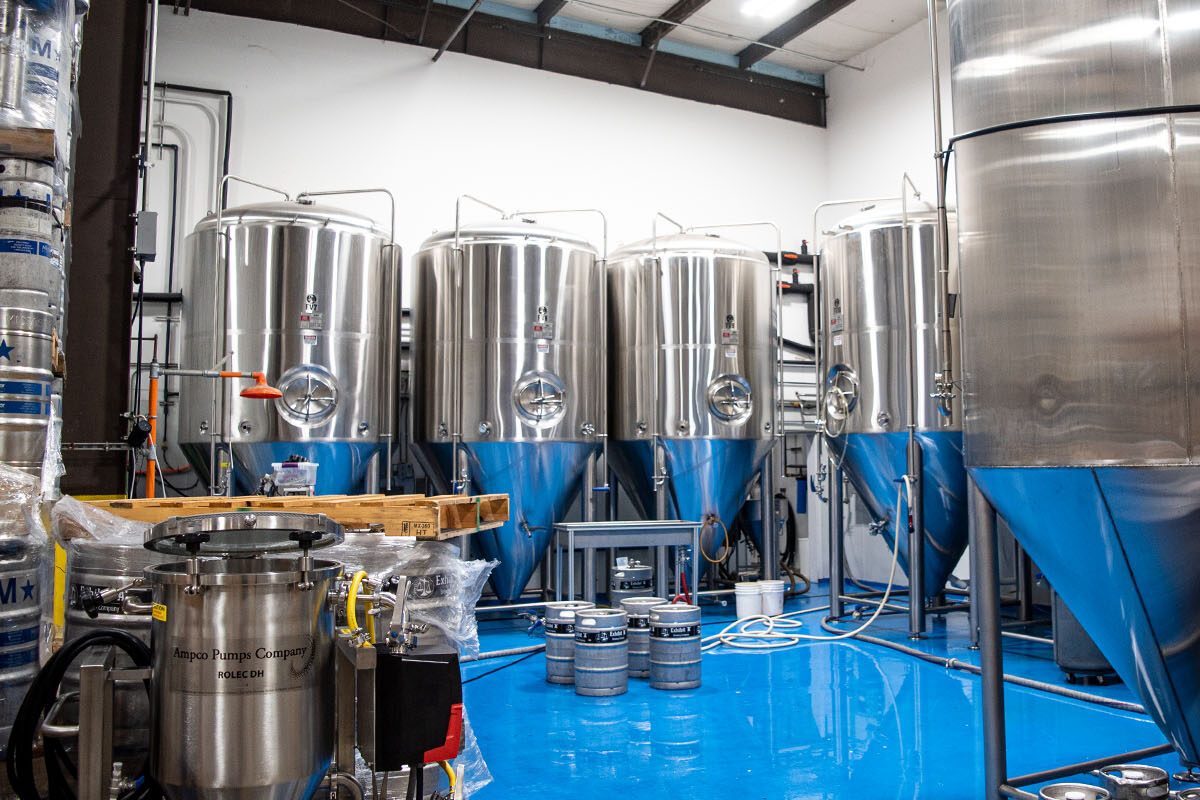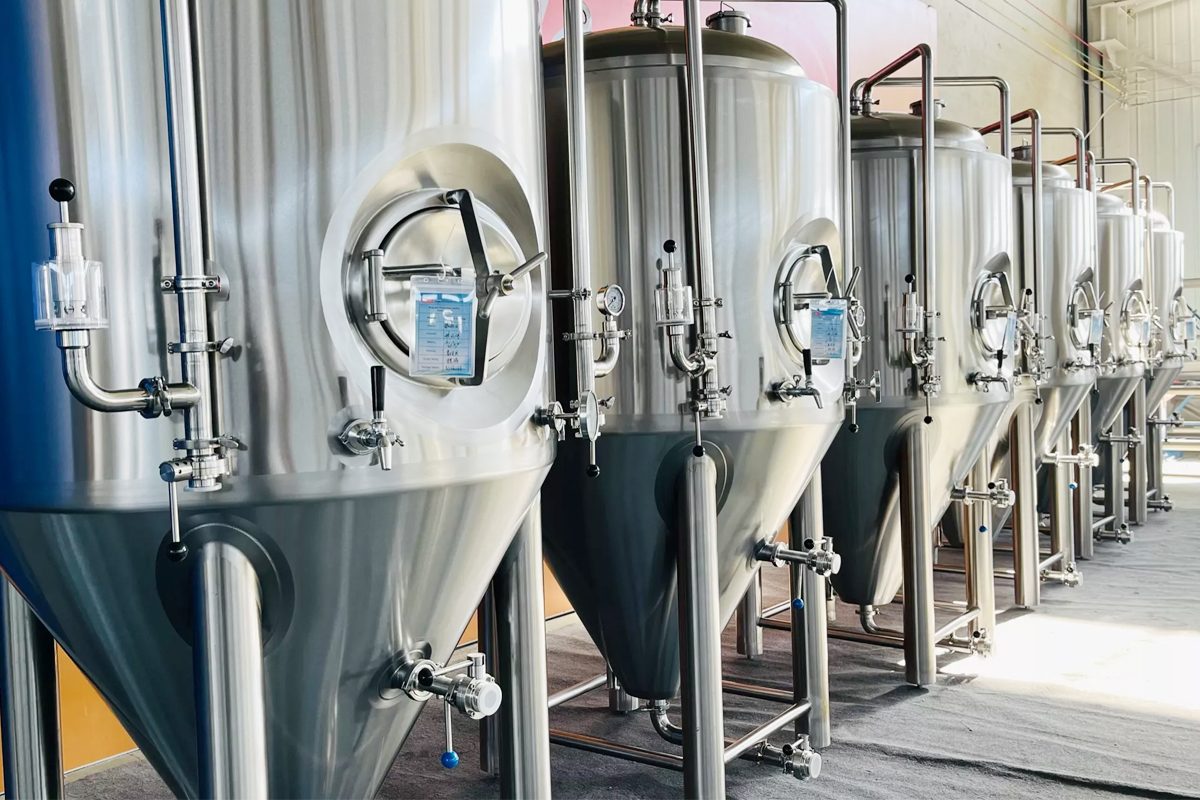
Factors To Consider When Selecting Fermentation Tanks
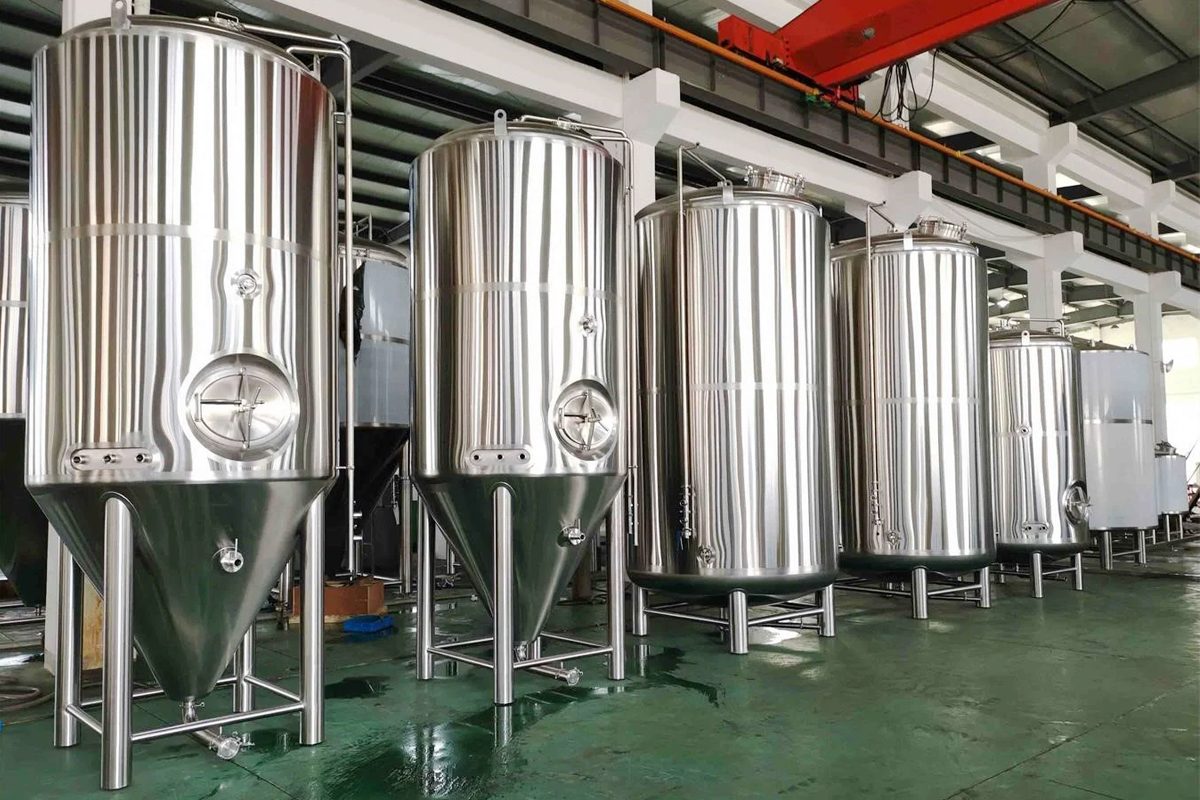
Material Construction
Stainless Steel
Stainless steel is the most common material used in commercial brewing for good reasons. It offers excellent corrosion resistance, durability, and a clean, sanitary surface that is easy to maintain. Within stainless steel, two primary grades are used:
- 304 Stainless Steel: This is the industry standard for fermentation tanks. It provides a high level of corrosion resistance and is suitable for most brewing processes. It is cost-effective and performs well under various environmental conditions.
- 316 Stainless Steel: For breweries that produce sour or acidic beers, 316 stainless steel is often preferred due to its superior corrosion resistance. It can withstand the harsh conditions associated with higher acidity levels and is ideal for environments exposed to aggressive cleaning chemicals.
Alternative Materials
While stainless steel is the dominant material, alternative materials like plastic, glass, or wood are sometimes used, though typically in niche or small-scale brewing operations.
- Plastic: Polyethylene or polypropylene tanks are often used for small or homebrewing setups. While they are lightweight and inexpensive, they are less durable and prone to scratching, which can harbor bacteria and lead to contamination.
- Glass: Some small-scale brewers may use glass fermentation tanks, but they are fragile, difficult to scale, and not suitable for commercial operations.
- Wood: Traditional wooden fermentation tanks, such as oak, are occasionally used for specialty beers like lambics or barrel-aged beers, where the wood itself contributes to the flavor profile. However, wooden tanks are challenging to clean and maintain, making them less practical for large-scale operations.
Why Stainless Steel is Superior
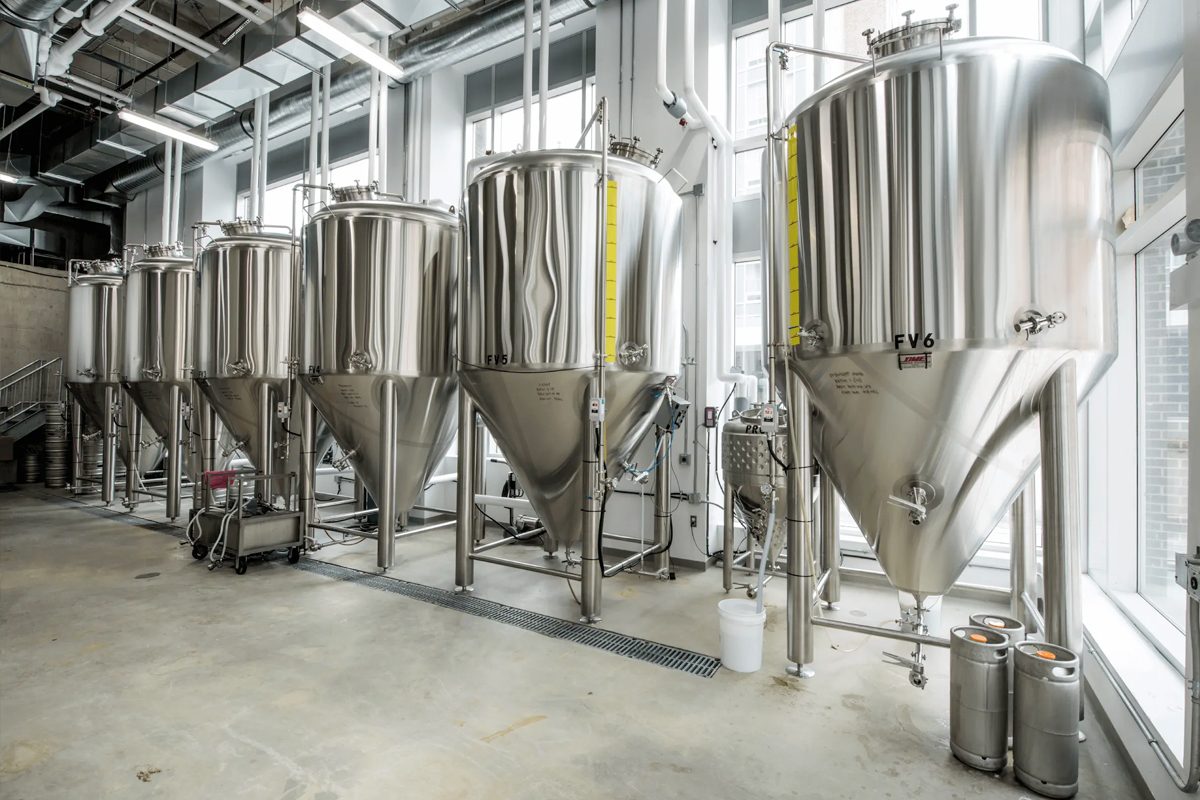
Tank Design
Cylindroconical Tanks
Cylindroconical tanks are the most common design used in modern breweries. These tanks have a cylindrical body with a conical bottom, which makes them highly efficient for managing yeast and sediment.
- Yeast Collection and Management: The conical bottom allows yeast to settle and be collected easily, which is especially useful for re-pitching yeast in future brews or separating it from the beer after fermentation.
- Enhanced Fermentation Control: The shape of cylindroconical tanks promotes even distribution of temperature and pressure, leading to more consistent fermentation. They also support pressurized fermentation, which can help brew certain beer styles (like lagers).
- Improved Cleaning: The smooth walls and angled bottom of these tanks make them easier to clean and sanitize, reducing contamination risks and ensuring high-quality output.
Horizontal Tanks
While cylindroconical tanks dominate the industry, horizontal tanks can also be used, particularly for specific beer styles such as lagers.
- Flavor Profile: Horizontal tanks provide more surface area for yeast to interact with the wort, leading to a different fermentation profile. They are often used for lagering, where a longer maturation time at lower temperatures is required.
- Space Considerations: Horizontal tanks can be useful for breweries with limited vertical space, as they take up more floor area but require less height.
Custom and Specialty Designs
Some breweries opt for custom-designed tanks to meet unique production needs or space constraints. These custom tanks are tailored to the specific brewing process or to fit into unusual spaces within a brewery.
- Multi-Purpose Tanks: Some fermentation tanks are designed to serve dual purposes, such as fermenting and aging, allowing for a more streamlined process in breweries with limited equipment.
- Unique Shapes and Features: Depending on the brewery’s goals, tanks can be designed with specialized features such as additional manways, sampling ports, or integrated systems for dry hopping or barrel aging.
Considerations for Small VS. Large Breweries
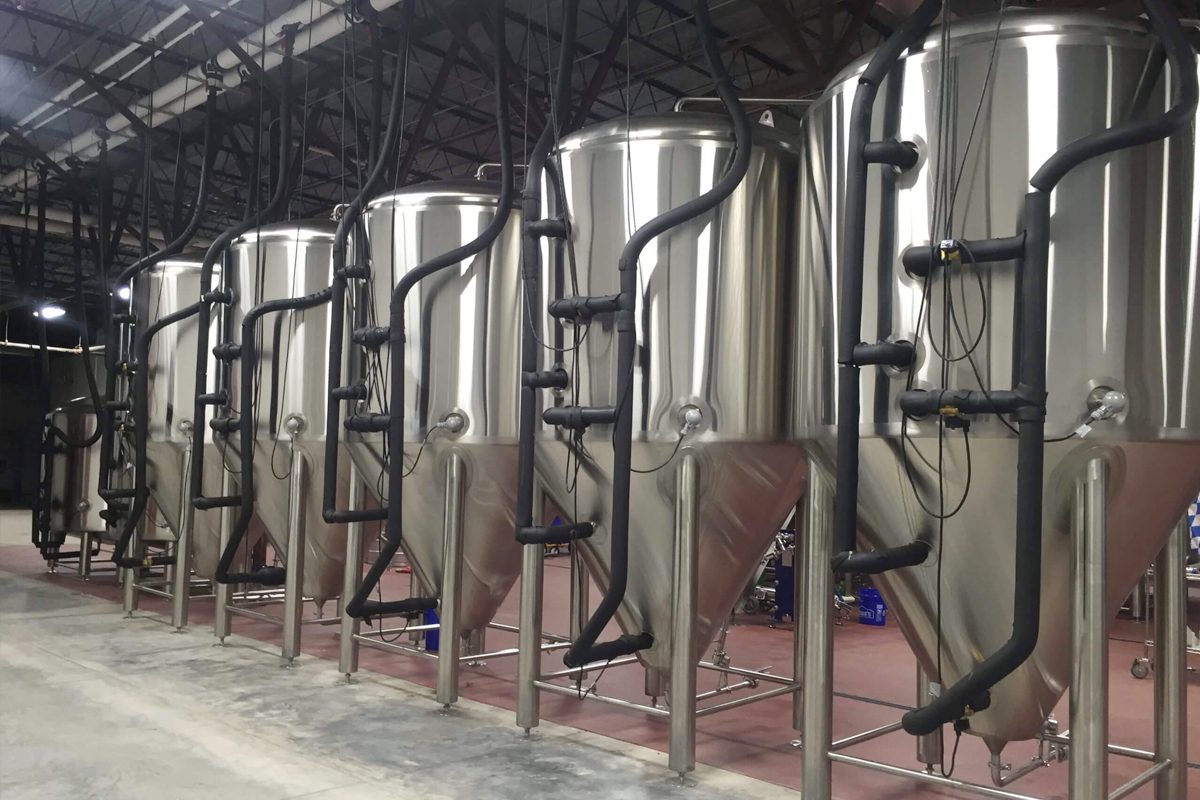
Volume Considerations and Scalability
Small-Scale Breweries
Medium to Large Breweries
Batch Flexibility
Modular Expansion
Future-Proofing Your Brewery
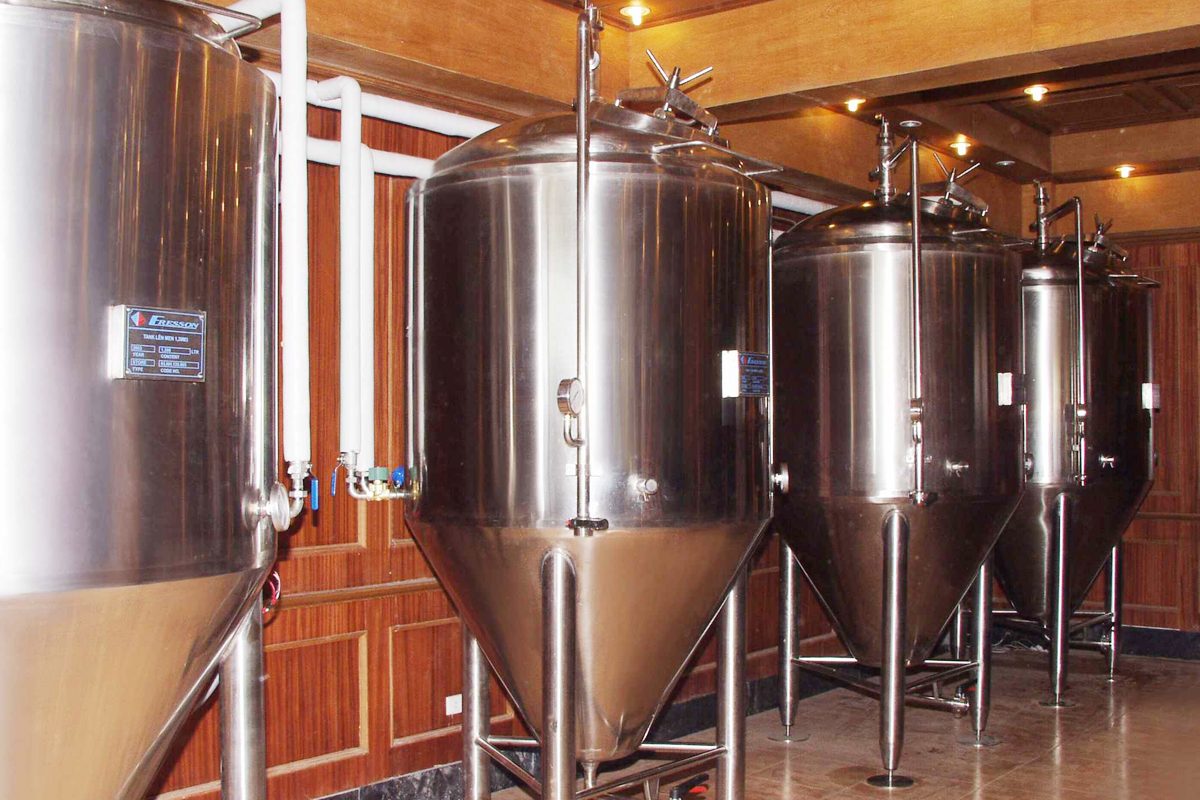
Shape of the Fermentation Tank
Cylindroconical Tanks
Cylindroconical tanks are the industry standard in most modern breweries due to their efficiency and versatility. These tanks feature a cylindrical body with a conical bottom, which allows for easy collection of yeast and sediments.
- Yeast Harvesting: The conical shape at the bottom of the tank helps yeast and trub settle, making it easier to separate and harvest yeast for reuse. This is especially important for breweries that focus on consistency across batches and want to reuse yeast multiple times.
- Pressure Control: The vertical design allows for better pressure control during fermentation, which is critical for beer styles like lagers. The cylindrical top ensures even pressure distribution, while the conical bottom supports pressurized fermentation, which helps maintain the desired carbonation level in the beer.
- Efficient Cleaning: The smooth walls and conical bottom also simplify cleaning and sanitation, reducing the risk of contamination. Cylindroconical tanks often come with Clean-In-Place (CIP) systems that further streamline maintenance.
Horizontal Tanks
Horizontal fermentation tanks are less common but are sometimes used in specific beer styles, especially in traditional lager production. Their horizontal design offers different benefits compared to vertical tanks.
- Surface Area for Yeast: The increased surface area of horizontal tanks allows yeast to interact more with the wort, which can lead to a slower, more controlled fermentation process. This is especially useful in lager production, where extended fermentation and maturation times are required.
- Space Efficiency: While horizontal tanks take up more floor space, they often fit better in breweries with height limitations. These tanks are also stacked horizontally in some cases, optimizing available space in facilities with low ceilings.
- Unique Flavor Profiles: Horizontal tanks can provide subtle variations in flavor, particularly in lagers, where slower yeast activity produces a cleaner, crisper beer.
Specialty and Custom Shapes
Some breweries opt for custom-shaped fermentation tanks to meet specific brewing processes or space constraints. Custom designs offer flexibility for breweries that require non-standard tank shapes to fit their production floor or want tanks optimized for certain beer styles.
- Square or Rectangular Tanks: These are rare but can be useful in niche applications or where space is a constraint. However, the lack of a conical bottom makes yeast management more challenging, requiring more manual intervention during cleaning and yeast removal.
- Open Fermentation tanks: While most modern breweries use closed fermentation tanks, some specialty beer styles, like traditional Belgian ales, benefit from open fermentation tanks. Open fermentation tanks allow natural yeast and bacteria to influence the fermentation process, contributing to the beer’s unique flavor profile. However, open tanks require a high level of sanitation and environmental control to avoid contamination.
Choosing the Right Shape for Your Brewery
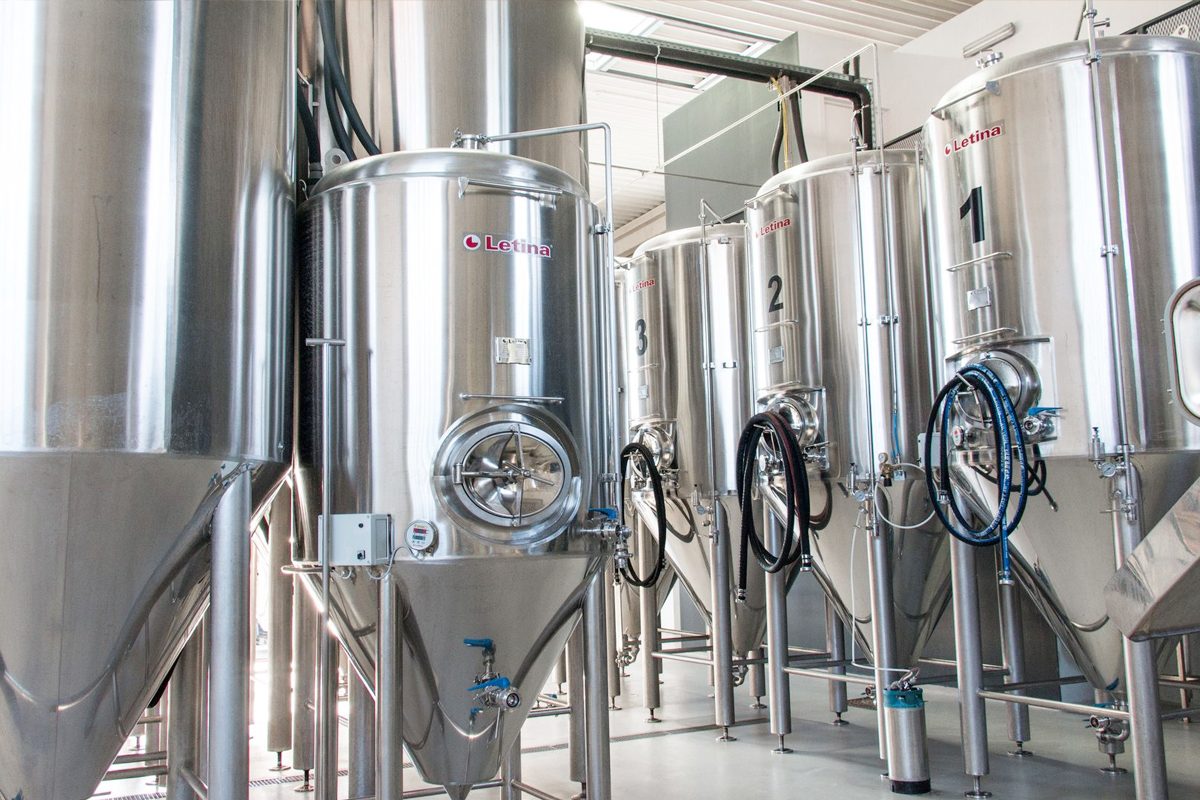
Cooling Jackets and Temperature Control
Importance of Temperature Control
Cooling Jackets
Cooling jackets are built-in systems that circulate coolant—usually glycol or chilled water—through the tank to maintain the desired temperature. These jackets are typically placed around the sides of the fermentation tank and come in different configurations depending on the brewery’s needs.
- Glycol Jackets: The most common type of cooling jacket uses glycol, a liquid coolant, to regulate the temperature inside the tank. Glycol is circulated through channels or dimpled jackets that wrap around the tank, pulling heat away from the fermenting beer. This system provides precise control and is highly efficient, especially for larger tanks.
- Multiple Cooling Zones: Larger tanks may have multiple cooling zones, allowing different parts of the tank to be cooled independently. This is important for controlling the fermentation process more accurately, especially in tall cylindroconical tanks where temperature stratification can occur.
- Energy Efficiency: A well-designed cooling jacket system minimizes energy consumption by maintaining stable temperatures, reducing the load on refrigeration units.
Insulation
In addition to a cooling jacket, proper insulation can maintain a consistent temperature within the fermentation tank. High-quality insulation prevents external heat from affecting the fermentation process, reducing energy consumption and improving efficiency.
- Double-Walled Tanks: Most commercial fermentation tanks are double-walled with insulation between the walls. This helps maintain a stable internal environment while minimizing the influence of ambient temperatures.
- Energy Savings: Well-insulated tanks not only ensure precise temperature control but also contribute to energy savings by reducing the workload on cooling systems.
Automated Temperature Control Systems
Many modern fermentation tanks are equipped with automated temperature control systems. These systems use temperature sensors placed inside the tank to continuously monitor the beer’s temperature and adjust the cooling system as needed. Automated controls provide several advantages:
- Precision: Automated systems allow brewers to set specific temperature profiles for different stages of fermentation. This ensures that the tank maintains the correct temperature for optimal yeast activity.
- Consistency: Automated systems help maintain consistent temperature conditions across multiple fermentation tanks, which is especially important in larger breweries where managing several batches simultaneously can be challenging.
- Remote Monitoring: Some advanced temperature control systems offer remote monitoring, allowing brewers to track and adjust fermentation temperatures from anywhere, ensuring the process runs smoothly even when not physically present in the brewery.
Heat Exchange Efficiency
Tailoring Temperature Control to Beer Styles
Different beer styles have unique fermentation temperature requirements. With precise control over the cooling jackets and temperature systems, brewers can create the ideal environment for various beer types:
- Ales: Typically require warmer fermentation temperatures, which need to be maintained to allow for quicker yeast activity.
- Lagers: Require cooler, longer fermentation periods. Cooling jackets are essential for maintaining the low temperatures necessary for lagering without fluctuations.
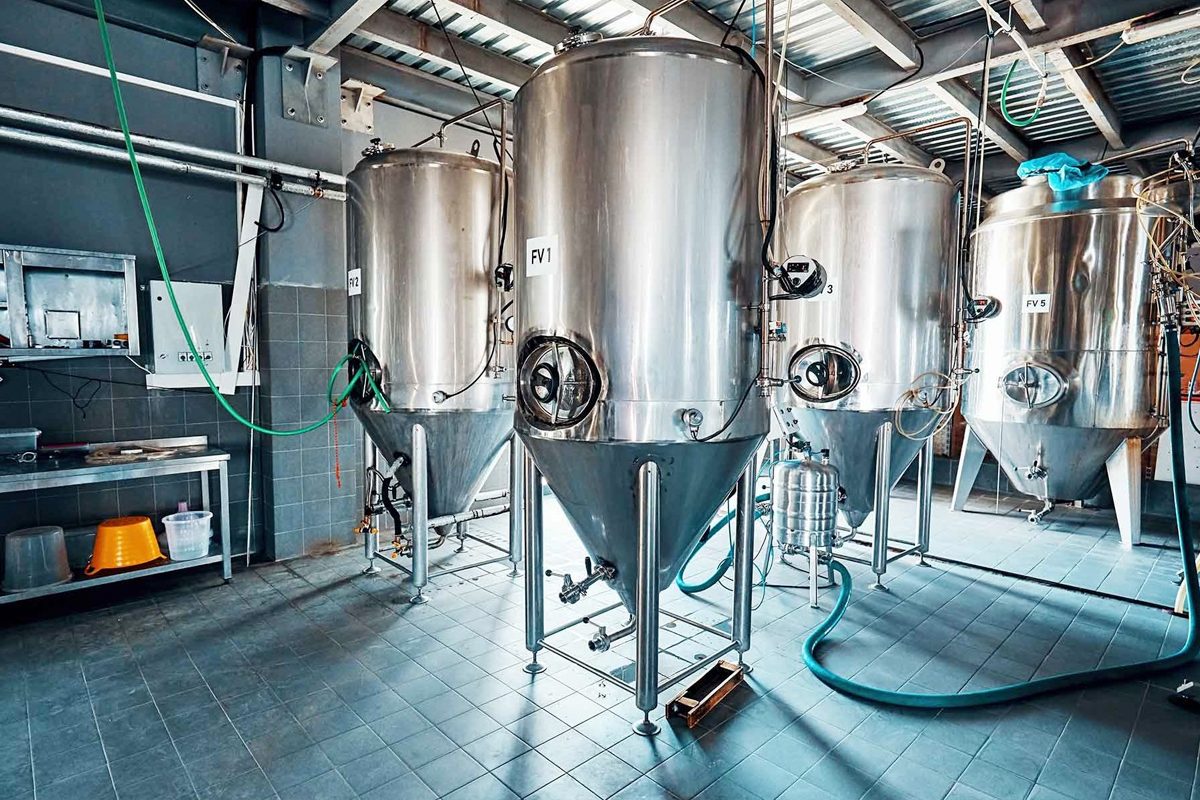
Pressure Vessels and Relief Valves
Importance of Pressure Vessels
Fermentation tanks are typically designed to handle varying levels of pressure based on the beer style and production process. Pressure vessels allow brewers to ferment and carbonate beer within a closed environment, preserving carbonation and ensuring precise control over the fermentation process.
- Fermentation Under Pressure: In some styles, such as lager, fermentation under controlled pressure can maintain carbonation and achieve specific flavors. Fermentation under pressure also helps to speed up the fermentation process, reducing unwanted esters and keeping dissolved CO2 levels optimal.
- Carbonation Management: Pressure vessels are ideal for managing carbonation levels during fermentation. With the ability to control pressure, brewers can naturally carbonate beer within the tank, reducing the need for force carbonation after fermentation is complete.
- Pressure Ratings: When selecting fermentation tanks, it’s critical to ensure they are rated to handle the pressure demands of your brewing process. Tanks that aren’t rated for sufficient pressure can lead to safety hazards, such as tank deformation or even rupture.
Relief Valves
Relief valves are an essential safety feature for any pressure-rated fermentation tank. They prevent over-pressurization by releasing excess gas when pressure levels exceed a safe threshold. This is particularly important during active fermentation when CO2 production is at its peak.
- Pressure Relief Valves: These valves are designed to automatically open when the internal pressure reaches a predetermined level, releasing excess gas to avoid damage to the tank or safety risks for brewery staff. Pressure relief valves are typically adjustable, allowing brewers to set specific pressure limits based on the beer style and fermentation requirements.
- Blow-Off Valves: In addition to pressure relief valves, blow-off valves can be used to release built-up CO2 in a controlled manner. These valves divert excess gas through a blow-off tube, which helps prevent contamination or exposure to outside air. Blow-off valves are often used during the most active phase of fermentation when CO2 production is at its highest.
- Safety Compliance: All fermentation tanks designed to handle pressure must meet industry safety standards, such as ASME or European pressure vessel certifications, to ensure that they operate safely under high-pressure conditions.
Balancing Pressure Control with Flavor Development
Pressure management is not just about safety, it also influences the final product. During fermentation, yeast behavior can change under varying pressure conditions, which in turn affects the flavor and aroma of the beer.
- Low Pressure for Ales: Ales generally ferment at lower pressures, allowing for more ester production and resulting in a fruitier, more aromatic beer. Relief valves can help maintain lower pressure levels during ale fermentation to achieve the desired flavor profile.
- Higher Pressure for Lagers: Lagers, on the other hand, benefit from higher pressure during fermentation. The controlled pressure helps produce a cleaner flavor and maintains natural carbonation levels. Pressure vessels and relief valves work together to allow for precise pressure control without risking over-pressurization.
Maintaining Tank Integrity
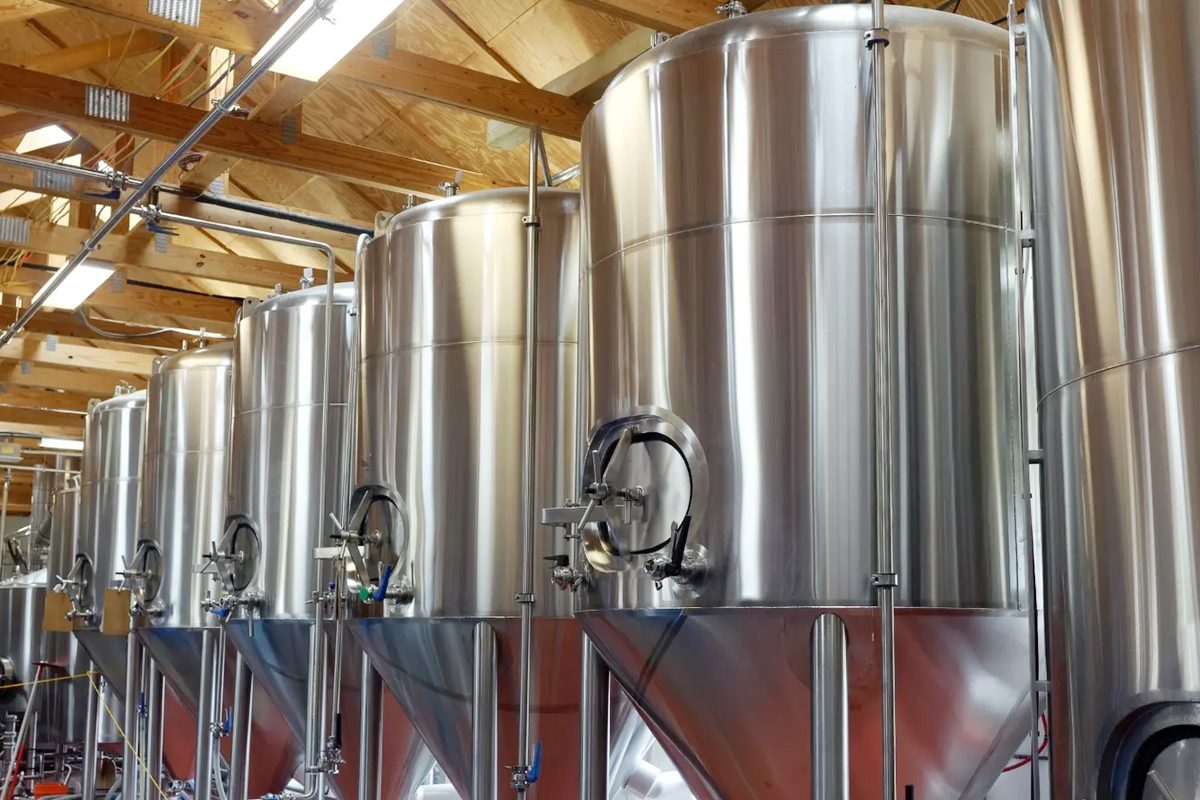
Manways and Access Ports
Manways
Manways are large openings in the fermentation tank that provide brewers with easy access to the tank’s interior. Proper placement and design of manways are essential for cleaning, inspecting, and performing routine maintenance on the tank.
- Top Manways: Located at the top of the tank, these manways are common in cylindrical and conical tanks. Top manways allow access to cleaning tools and hoses while minimizing the risk of contamination since they remain above the liquid level during fermentation.
- Side Manways: Positioned on the side of the tank, typically closer to the bottom, side Manways provide more convenient access for manual cleaning or inspections, especially when the tank needs to be fully emptied. This type of manway is particularly useful for cleaning out yeast and trub that accumulate at the bottom of cylindroconical tanks.
- Ease of Access: The size and positioning of manways directly affect how easily brewers can access the inside of the tank. Large, well-placed manways make it easier to reach all areas of the tank for thorough cleaning and maintenance, helping to maintain sanitation and ensure the quality of future batches.
Access Ports
Access ports are smaller openings in the tank that serve various purposes, such as sampling, monitoring, or adding ingredients during fermentation. The correct configuration of access ports can significantly enhance operational efficiency and provide brewers with more control over the fermentation process.
- Sampling Port: Sampling ports can help take small amounts of beer during fermentation to monitor yeast activity, gravity, and flavor development. Well-designed sampling ports allow brewers to take samples without opening the tank, reducing the risk of contamination.
- Sensor Ports: Many fermentation tanks come equipped with ports designed for temperature and pressure sensors. These sensors provide real-time data on the fermentation process, allowing brewers to monitor conditions and make necessary adjustments without interrupting the fermentation.
- Ingredient Addition Ports: Some tanks feature ports specifically for adding ingredients such as hops, fruit, or spices during fermentation. These ports enable brewers to introduce additional elements into the beer without exposing the entire tank to outside air, preserving sanitation and preventing contamination.
Sanitation and Sealing Mechanisms
Both manways and access ports must have airtight sealing mechanisms to ensure the tank remains completely sealed during fermentation, preventing contamination and maintaining consistent pressure levels.
- Gasket Seals: High-quality gaskets are used in manways and access ports to create a tight seal, preventing air or contaminants from entering the tank. These gaskets must be durable and resistant to the cleaning chemicals used in breweries.
- Clamp or Screw Mechanisms: Manways and ports often use clamp or screw mechanisms to secure the openings. These should be easy to operate but also provide a strong seal to maintain the tank’s internal environment.
Customization for Operational Needs
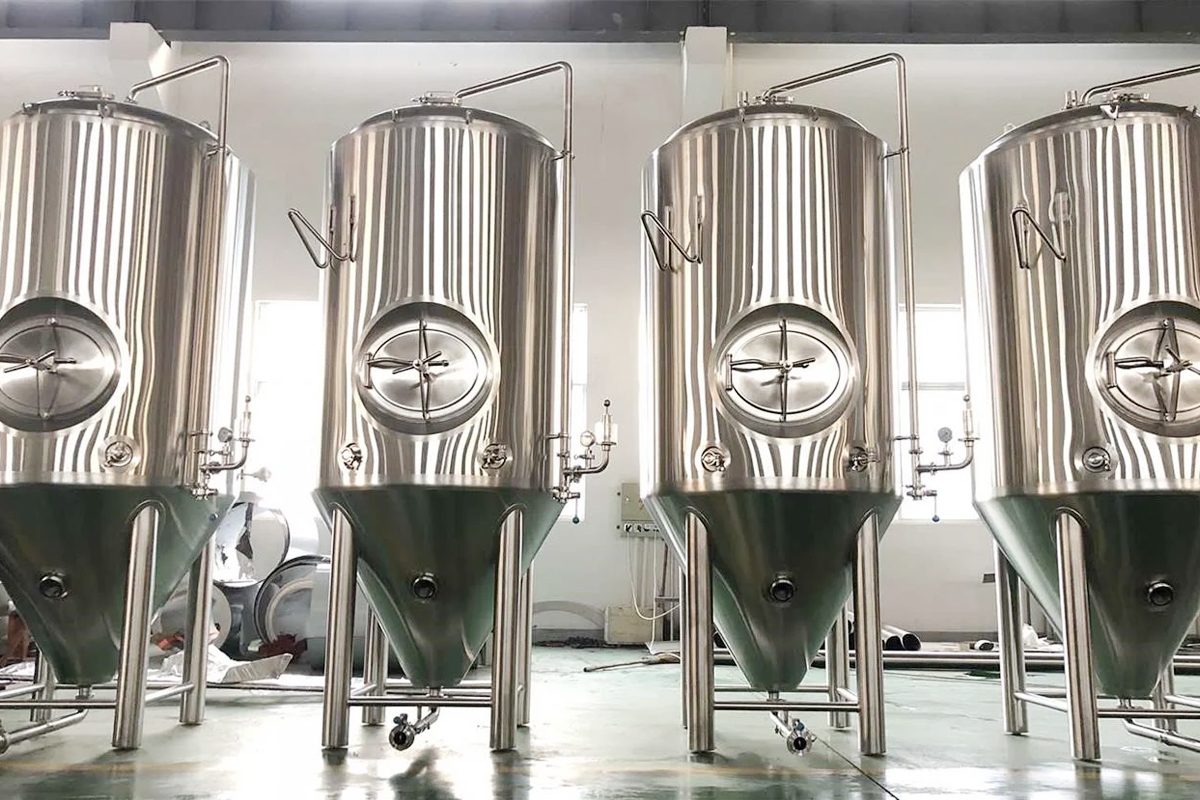
Cleaning and Sanitization Systems (CIP Systems)
What Is a CIP System?
Key Components of CIP Systems
Effective CIP systems are designed with several essential components that work together to ensure thorough cleaning and sanitization:
- Spray Balls: Spray balls are installed inside the tank and connected to the cleaning solution delivery system. These nozzles spray high-pressure cleaning solutions onto all interior surfaces of the tank, ensuring that every part is cleaned evenly. Some systems use rotating spray balls to cover more surface area, improving the efficiency of the cleaning process.
- Pumps: Pumps are used to circulate cleaning agents through the tank during the CIP process. Depending on the system, different chemicals—such as caustic solutions, sanitizers, and rinsing water—are cycled through the tank to remove organic materials and sanitize the interior.
- Cleaning Solutions: Breweries use a combination of cleaning agents during the CIP process, including alkaline cleaners to remove organic deposits, acid cleaners to eliminate mineral buildup, and sanitizers to kill any remaining microorganisms. These solutions are selected based on the specific needs of the brewery and the materials used in the tank construction.
Benefits of CIP Systems
Implementing a CIP system provides several advantages for breweries, particularly in terms of operational efficiency and sanitation:
- Time and Labor Savings: CIP systems automate the cleaning process, significantly reducing the time and labor required to clean and sanitize tanks manually. This is especially valuable in larger breweries where several tanks need to be cleaned regularly.
- Consistent Cleaning: CIP systems ensure that every part of the tank is cleaned evenly, leaving no areas of potential contamination. This consistency helps maintain the quality and safety of each batch of beer.
- Reduced Risk of Contamination: Manual cleaning processes can introduce contaminants into the tank, especially if workers need to enter the tank. With a CIP system, the cleaning process is completely closed, minimizing the risk of contamination from outside sources.
- Improved Efficiency: CIP systems use optimized amounts of cleaning solutions, water, and energy, reducing waste and improving the overall efficiency of the cleaning process. This helps breweries reduce costs while maintaining high standards of sanitation.
Automation and Control Systems
Many modern CIP systems are fully automated, allowing brewers to set specific cleaning cycles for each tank. These automated systems can control the duration and temperature of each cleaning phase, ensuring that the cleaning process is optimized for the tank’s size and design. Additionally, automation allows brewers to monitor and adjust cleaning processes remotely, improving overall operational efficiency.
- Customizable Cleaning Programs: Breweries can create tailored cleaning programs for different stages of the brewing process or different types of beer, ensuring that each tank receives the appropriate level of cleaning and sanitization.
- Monitoring and Reporting: Advanced CIP systems provide real-time monitoring of cleaning parameters, including temperature, pressure, and chemical concentration, ensuring that cleaning is consistent and meets regulatory standards. This data can also be logged for quality assurance purposes.
Sanitation and Quality Assurance
Compliance with Industry Standards
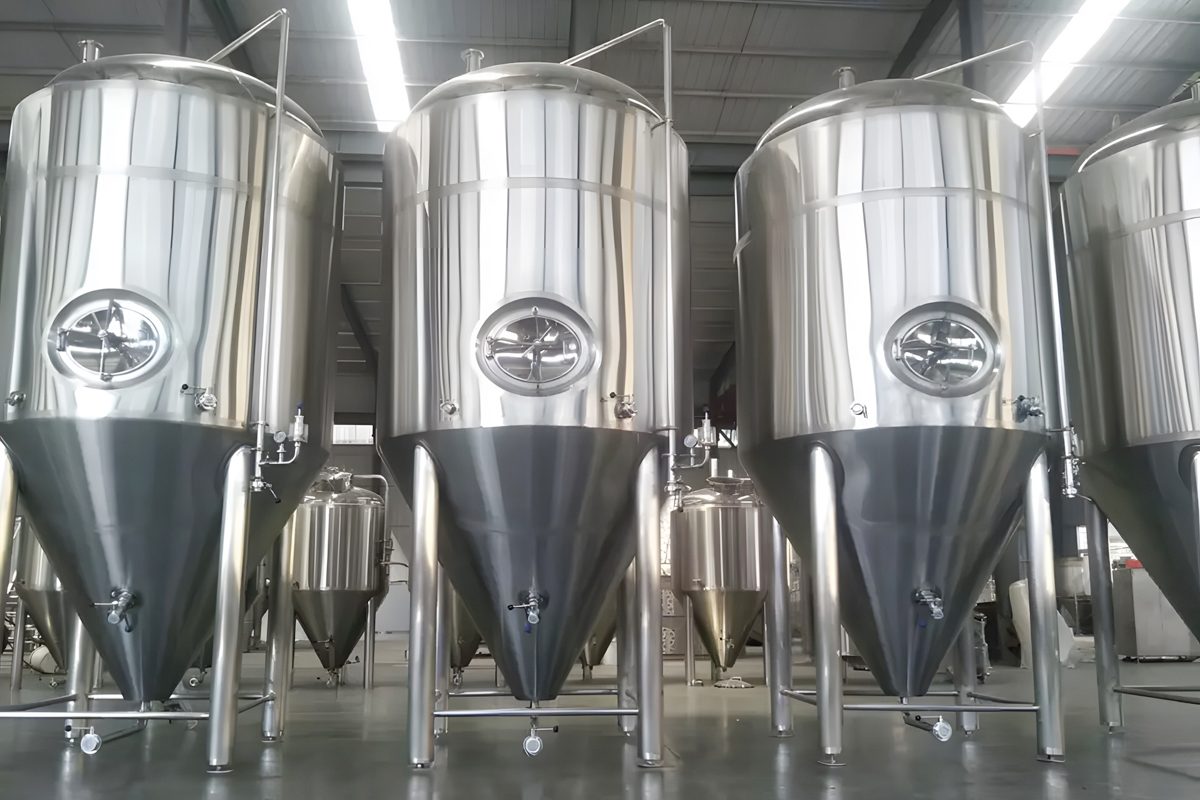
Agitators and Mixers
Purpose of Agitators and Mixers in Fermentation
Agitators and mixers are designed to keep the contents of the fermentation tank in motion, preventing settling and ensuring that ingredients remain well-integrated throughout the fermentation process. These systems can be used in various brewing applications to improve yeast contact with sugars, ensure homogeneity, and enhance flavor consistency.
- Uniform Yeast Distribution: In fermentation, yeast often settles at the bottom of the tank. Agitators and mixers help keep yeast suspended in the wort, ensuring that it remains in contact with fermentable sugars for optimal fermentation.
- Consistent Fermentation: By keeping the wort moving, mixers ensure an even temperature throughout the tank, reducing the chances of hot or cold spots that can lead to uneven fermentation. This is particularly important in large fermentation tanks, where temperature variation can affect the quality of the final product.
- Solid Additions: For beers that include added fruits, spices, or other solids, agitators help mix these ingredients evenly into the wort. This ensures consistent flavor and texture throughout the entire batch.
Types of Agitators and Mixers
The choice of agitator or mixer depends on the specific needs of the brewing process and the type of beer being produced.
- Mechanical Agitators: These agitators use rotating blades or paddles to keep the wort in motion. They are often used in high-gravity brewing or when working with heavy, dense ingredients. Mechanical agitators are typically installed on the top or side of the tank and are powered by a motor.
- Static Mixers: Instead of mechanical movement, static mixers rely on the natural flow of the wort to create mixing. These systems use fixed structures inside the tank that cause the liquid to change direction as it flows, promoting mixing without the need for moving parts.
- Propeller or Impeller Agitators: Propeller or impeller systems are commonly used in large fermentation tanks. They feature a rotating blade mounted on a vertical shaft, which creates a circular motion to ensure thorough mixing. This type of agitator is particularly effective in keeping the yeast suspended and the wort well-mixed.
Applications of Agitators and Mixers in Brewing
Agitators and mixers are not necessary for every brewing application, but they are particularly useful in certain types of fermentation processes:
- High-Gravity Brewing: In high-gravity brewing, where the wort contains higher concentrations of fermentable sugars, agitators help keep yeast active and evenly distributed. This ensures that fermentation proceeds smoothly, reducing the risk of stuck fermentation.
- Fruit and Spice Beers: Beers that incorporate fruits, spices, or other solid ingredients benefit from agitators, as they help ensure that the added ingredients are consistently mixed throughout the wort. Without proper mixing, these solids could settle at the bottom, leading to uneven flavor distribution.
- Sour Beers and Barrel Aging: Agitators can also be useful in managing complex fermentation processes such as souring or barrel aging, where a consistent interaction between yeast, bacteria, and wort is required to develop the beer’s unique flavor profile.
Maintenance and Operational Considerations
When choosing agitators and mixers, breweries must consider ease of maintenance and operational efficiency. Mechanical agitators, for instance, may require regular cleaning and maintenance to prevent the buildup of residue or potential mechanical failure. Properly designed systems ensure that agitators are easy to access for cleaning and servicing.
- CIP Compatibility: Many agitators and mixers are designed to be compatible with Clean-In-Place (CIP) systems, allowing them to be cleaned without the need for disassembly. This feature saves time and reduces the risk of contamination during the cleaning process.
- Energy Efficiency: Mechanical agitators can increase energy consumption, so choosing energy-efficient systems with variable speed settings can help reduce operational costs. Static mixers, on the other hand, have no moving parts and consume no additional energy, making them an economical choice for certain brewing processes.
Customization for Specific Brewing Needs
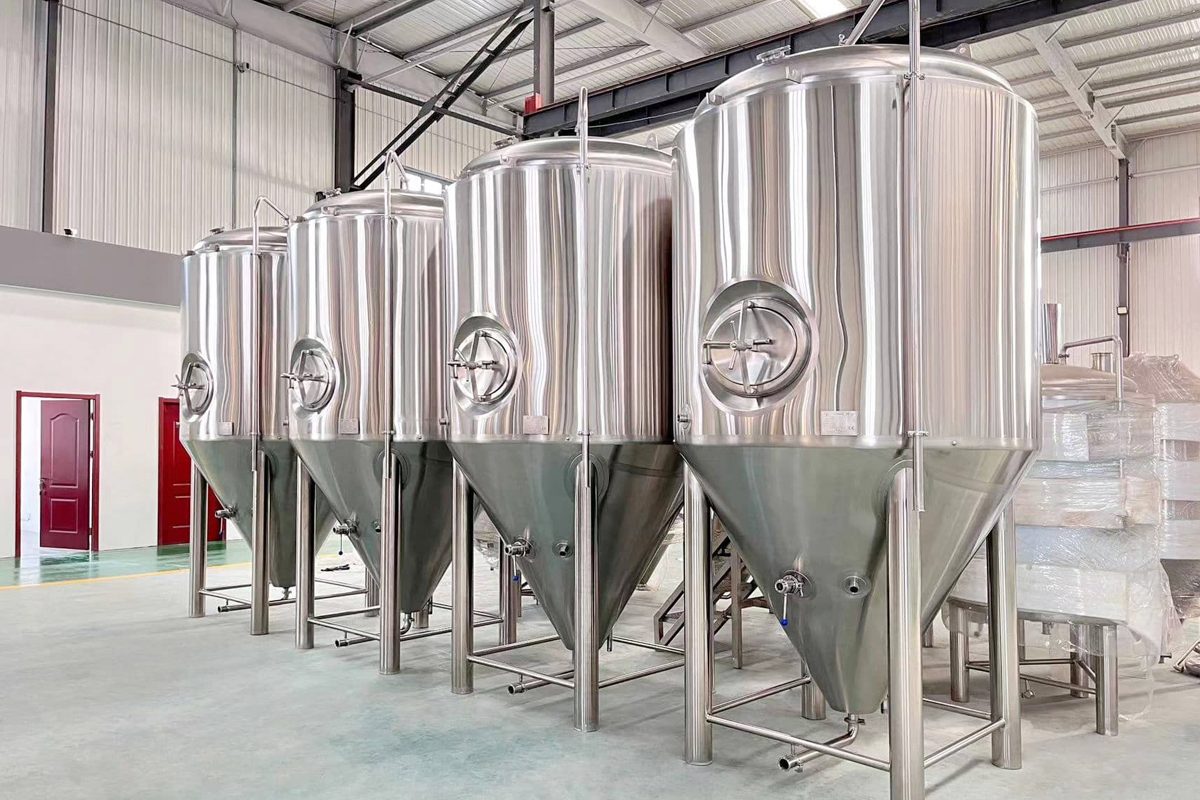
Structural Integrity and Safety Features
Material Strength and Durability
The structural integrity of a fermentation tank begins with the materials used in its construction. Stainless steel is the preferred material for most commercial breweries because of its strength, corrosion resistance, and ability to handle high pressure.
- Stainless Steel Construction: Tanks made from 304 or 316 stainless steel offer the necessary durability to withstand the high pressure generated during fermentation, particularly in pressurized tanks. The tank must also resist corrosion from acidic conditions, especially in the case of sour beers or when using aggressive cleaning agents.
- Welding and Fabrication: High-quality welds help maintain the tank’s structural integrity. Poorly welded seams can create weak points that may lead to leaks or contamination over time. It’s crucial to ensure that tanks are manufactured with precision welding techniques to eliminate these vulnerabilities.
Pressure Ratings and Certification
Fermentation tanks must be pressure-rated according to the demands of the brewing process. Some beer styles, such as lagers, require pressurized fermentation, so the tank must be built to handle these conditions safely.
- Pressure Rating: Tanks must be certified to handle specific pressure levels, especially for those designed for pressurized fermentation. The tank’s maximum working pressure should align with the brewery’s production processes and safety standards.
- Compliance with Standards: Fermentation tanks must meet industry standards and certifications such as ASME (American Society of Mechanical Engineers) or equivalent certifications in other regions. These certifications ensure that the tank has undergone rigorous testing and is suitable for commercial use.
Tank Stands and Support Structures
The stability of fermentation tanks is essential for safe operation, especially in larger breweries where tanks can hold thousands of liters of liquid. The support structure must be designed to bear the weight of both the tank and its contents.
- Tank Stands: Fermentation tanks typically rest on custom-designed stands that provide a solid foundation. The stand must be robust enough to support the full capacity of the tank without risk of collapse or shifting.
- Seismic Considerations: In regions prone to seismic activity, tanks and their support structures may need to be designed to meet earthquake safety standards. This ensures that the tank remains secure and stable during seismic events.
Safety Valves and Pressure Relief Systems
Safety features such as the pressure release valve prevent accidents during the fermentation process. As yeast converts sugars into carbon dioxide, pressure can build up inside the tank, especially in sealed or pressurized systems.
- Pressure Relief Valves: These valves automatically release excess pressure when it reaches a certain threshold, preventing over-pressurization that could damage the tank or cause a safety hazard. Properly functioning pressure relief valves are essential for maintaining safe operation, particularly during high-pressure fermentations.
- Emergency Stop Mechanisms: Some tanks are equipped with emergency stop features that automatically halt the fermentation process or release pressure in the event of a malfunction or unexpected pressure build-up.
Insulation and Thermal Integrity
Maintaining consistent fermentation temperatures is vital for ensuring product quality. Proper insulation not only aids temperature control but also contributes to the tank’s overall structural integrity by preventing thermal expansion and contraction, which can weaken the tank over time.
- Thermal Expansion Protection: Repeated heating and cooling cycles can cause materials to expand and contract, potentially leading to cracks or weak points in the tank. Tanks designed with thermal expansion in mind, using high-quality insulation and flexible joints, help prevent these issues.
- Efficient Insulation: Insulation helps reduce energy consumption by keeping fermentation temperatures stable, protecting the tank’s structure from external temperature fluctuations, and preventing condensation on the tank’s exterior, which can lead to corrosion.
Safety Sensors and Monitoring Systems
Modern fermentation tanks often come equipped with sensors that monitor pressure, temperature, and liquid levels. These sensors ensure that the tank operates within safe parameters and provide real-time data that can help prevent potential issues before they become critical.
- Temperature and Pressure Sensors: Integrated sensors provide constant monitoring of internal tank conditions, alerting brewers to any significant deviations from safe operating ranges. This allows for quick adjustments or interventions to maintain both product quality and operational safety.
- Remote Monitoring Systems: Advanced tanks may feature remote monitoring capabilities, allowing brewers to track fermentation conditions from off-site locations. These systems often include alarms that trigger if pressure or temperature levels move outside of safe thresholds, providing an added layer of security.
Long-Term Durability and Maintenance
Maintaining the structural integrity of fermentation tanks over time is critical to ensuring their safe and efficient use. Regular maintenance, including inspections and the replacement of worn-out parts, can prevent long-term structural issues.
- Routine Inspections: Regular visual inspections of welds, seals, and pressure relief valves help identify potential problems early on. Maintenance schedules should also include periodic pressure testing to ensure that tanks are operating within their designed safety limits.
- Component Replacement: Over time, certain components such as gaskets, seals, and valves may wear out. Ensuring that these parts are replaced before they fail can prevent leaks and pressure issues, maintaining the overall safety of the tank.
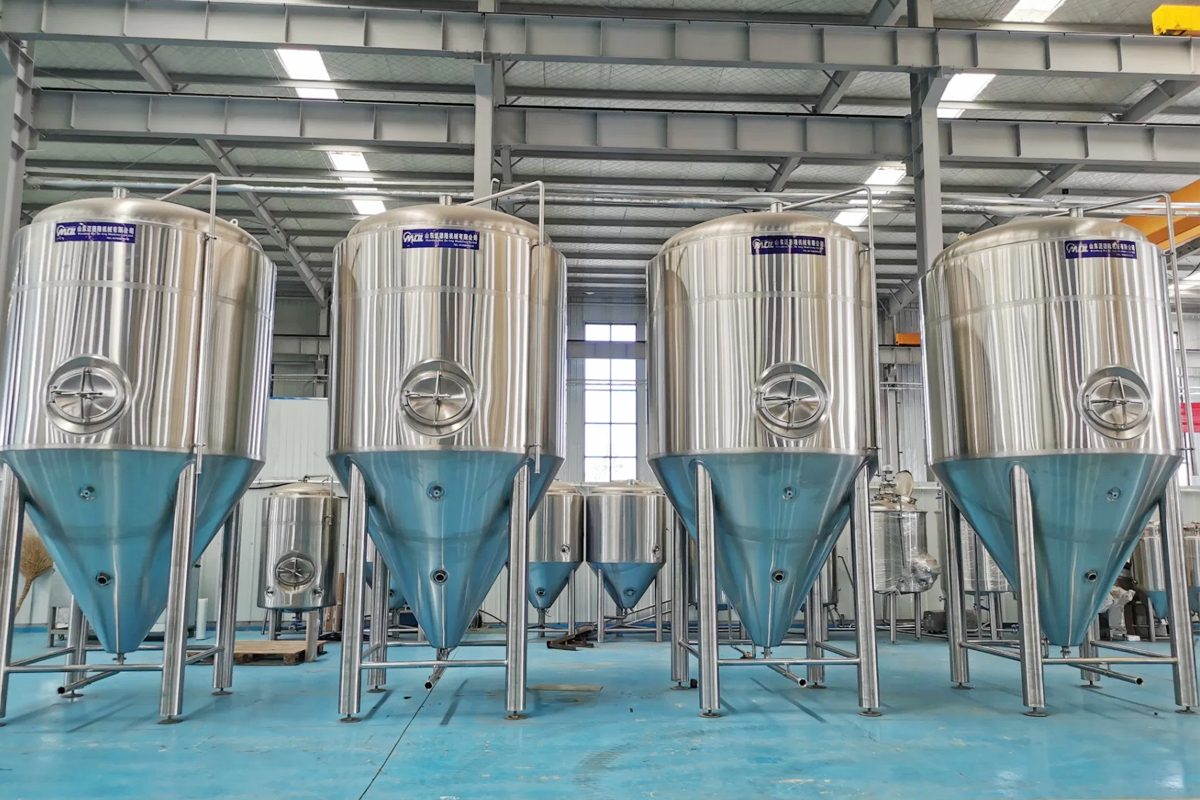
Specialized Fermentation Processes
Spontaneous Fermentation
Spontaneous fermentation involves allowing wild yeast and bacteria present in the environment to ferment the wort, rather than adding cultivated yeast strains. This method is most famously used in the production of traditional Belgian Lambic and other wild ales.
- Open Fermentation tanks: For spontaneous fermentation, open fermentation vessels are often used, allowing the wort to be exposed to air and naturally occurring microbes. These tanks must be carefully positioned in environments with clean air circulation to avoid unwanted contamination.
- Material Considerations: While stainless steel is often used, some brewers prefer wooden tanks or fermentation tanks for this process to impart additional complexity and flavor to the beer. The wood can also harbor its microbial communities, further contributing to the beer’s character.
High-Gravity Brewing
High-gravity brewing involves producing wort with a higher-than-usual concentration of fermentable sugars, resulting in beers with higher alcohol content. This process requires tanks that can handle the increased stress and ensure optimal yeast activity.
- Robust Agitation Systems: High-gravity worts are denser and require more efficient mixing to maintain even yeast distribution and nutrient contact. Fermentation tanks with built-in agitators or mixers help maintain uniform fermentation in these conditions.
- Cooling Systems: Since high-concentration fermentations generate more heat due to increased yeast activity, tanks with enhanced cooling jackets can help maintain a steady fermentation temperature.
Sour Beer Production
Sour beer production requires tanks that can withstand higher acidity levels due to the introduction of lactobacillus, pneumococcus, or other acid-producing bacteria.
- Corrosion-Resistant Materials: Tanks made from 316 stainless steel are often preferred for sour beer production because of their enhanced resistance to acidic environments. This ensures that the tank remains durable and safe even when exposed to high levels of acidity over time.
- Segregated Equipment: Many breweries choose to dedicate specific tanks for sour beer production to avoid cross-contamination with non-sour beers. This often requires specialized tanks or fermentation systems to keep the souring bacteria isolated.
Barrel Aging and Oak Fermentation
Barrel aging or fermentation in wooden tanks adds unique flavors and complexity to the beer, as the wood itself imparts tannins, vanillin, and other compounds.
- Wooden Fermentation Vessels: Oak barrels or wooden fermentation tanks are commonly used for aging beers like stouts, sours, or saisons. These vessels allow for micro-oxidation, which contributes to the development of complex flavors over extended aging periods.
- Tank Shape: In some cases, the shape of the tank can affect the interaction between the beer and the wood. For example, wide, horizontal tanks provide more surface area for contact between the liquid and the wood, resulting in a quicker infusion of flavors.
Mixed Fermentation
In mixed fermentation, both traditional brewer’s yeast (Saccharomyces cerevisiae) and wild yeast or bacteria (such as Brettanomyces) are used to create complex flavor profiles. This process requires tanks that can manage the unique fermentation timelines and conditions of multiple yeast strains.
- Multiple Ports and Sampling Valves: Tanks with additional sampling ports allow brewers to closely monitor and sample the beer at different stages of fermentation to track the activity of both yeast and bacteria. This level of control is essential for mixed fermentation processes, which often take longer to complete.
- Temperature Control Flexibility: Mixed fermentation often requires fluctuating temperatures to encourage the activity of different organisms at different stages of the process. Fermentation tanks equipped with precise temperature control systems allow brewers to manage these shifts without compromising the beer.
Dry Hopping and Late Ingredient Additions
Some beer styles, like IPAs, require late additions of hops or other ingredients during fermentation to impart bold aromas and flavors.
- Dry Hop Ports: Specialized fermentation tanks may have dedicated dry hop ports or larger access ports to easily add hops or other ingredients after the primary fermentation has started. These ports should be large enough to accommodate dry hopping while ensuring airtight sealing to prevent oxygen exposure.
- Airtight Seals and Pressure Management: Airtight seals are especially important during dry hopping or ingredient addition to prevent oxygen from entering the tank and oxidizing the beer. Some tanks are also designed to handle additional pressure during this process to maintain optimal carbonation.
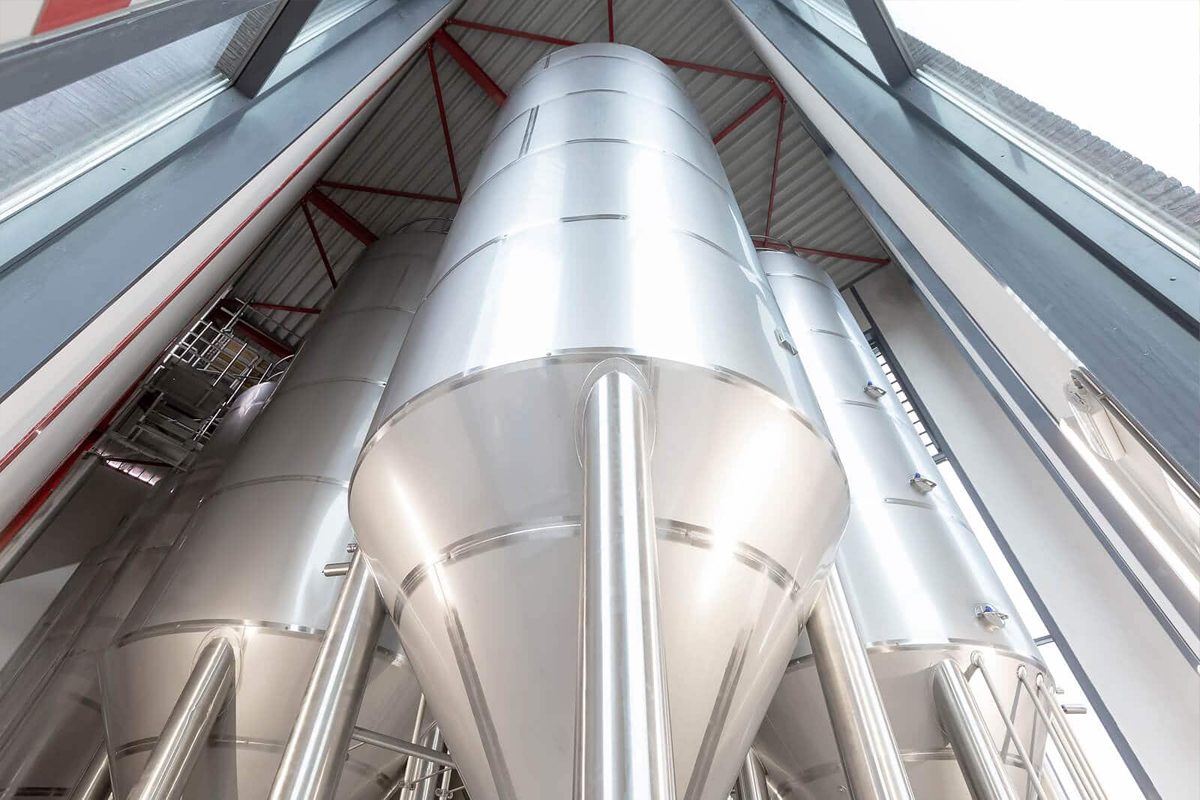
Compliance with Industry Standards
ASME Certification
The American Society of Mechanical Engineers (ASME) sets widely recognized standards for pressure vessels, including fermentation tanks that are used in pressurized environments. Fermentation tanks that meet ASME standards have undergone rigorous testing and certification processes to ensure they can safely handle the pressure generated during fermentation, particularly in pressurized systems like lagering or carbonation.
- Pressure Vessel Compliance: Tanks rated for pressurized fermentation must be certified by ASME or an equivalent organization to ensure they can withstand the required pressure levels without compromising safety.
- Durability and Reliability: ASME certification guarantees that the tanks have been constructed to withstand repeated pressure changes, offering long-term reliability and minimizing the risk of structural failure or accidents.
FDA and Food Safety Compliance
In breweries, fermentation tanks must meet food safety regulations set by organizations such as the U.S. Food and Drug Administration (FDA) to ensure that the equipment does not compromise the quality or safety of the beer. This includes ensuring that materials used in tank construction are safe for contact with food and beverages and that cleaning and sanitization processes meet hygiene standards.
- Food-Grade Materials: Tanks should be made from food-safe materials, such as stainless steel, which is resistant to corrosion and easy to clean. The use of non-reactive materials helps prevent contamination and maintains the integrity of the beer throughout the fermentation process.
- Hygiene Standards: Tanks must be designed for ease of cleaning and sanitization, with features like Clean-In-Place (CIP) systems and smooth, non-porous surfaces that prevent the buildup of bacteria or residue.
European Brewery Standards
For breweries operating in Europe or exporting beer internationally, compliance with European standards, such as those set by the European Union or specific countries, is essential. The CE (Conformité Européene) marking is one such standard that certifies equipment meets EU safety, health, and environmental protection requirements.
- CE Marking: Tanks used in European breweries must carry the CE marking, ensuring that they meet the safety and operational standards required in the EU market.
- ISO Standards: Compliance with ISO (International Organization for Standardization) standards for manufacturing, such as ISO 9001, helps ensure that tanks are produced consistently and reliably, with a focus on quality management throughout the production process.
Occupational Safety Standards
Fermentation tanks must also meet occupational safety regulations to protect brewery workers from potential hazards. This includes compliance with guidelines set by organizations such as the Occupational Safety and Health Administration (OSHA) in the U.S. or its equivalents in other countries.
- Worker Safety: Tanks should be equipped with safety features such as pressure relief valves, emergency stop systems, and proper insulation to protect workers from heat or pressure-related accidents.
- Safe Access Points: Compliance with occupational safety standards also ensures that tanks have safe and accessible manways, ladders, or platforms, enabling workers to clean and maintain the tanks safely without risking injury.
Environmental Standards
Environmental standards also play a role in the design and operation of fermentation tanks. Many breweries aim to reduce their environmental impact by using energy-efficient equipment and following regulations related to waste management and emissions.
- Energy Efficiency: Tanks designed to minimize energy use, such as those with efficient insulation or optimized cooling systems, can help breweries reduce their carbon footprint while complying with environmental standards.
- Waste Management: Compliance with local environmental laws may require breweries to manage waste products, such as yeast and wastewater, responsibly. Fermentation tanks should be designed to facilitate easy cleaning and disposal of byproducts, ensuring compliance with environmental regulations.
Third-Party Audits and Certifications
- Third-Party Audits: Regular inspections and audits by accredited organizations ensure that the fermentation tanks and brewing processes meet the highest standards of safety and quality.
- HACCP and Food Safety: Implementing a HACCP system ensures that fermentation tanks and the entire brewing process are designed and managed to prevent contamination, maintain food safety, and ensure consistent product quality.
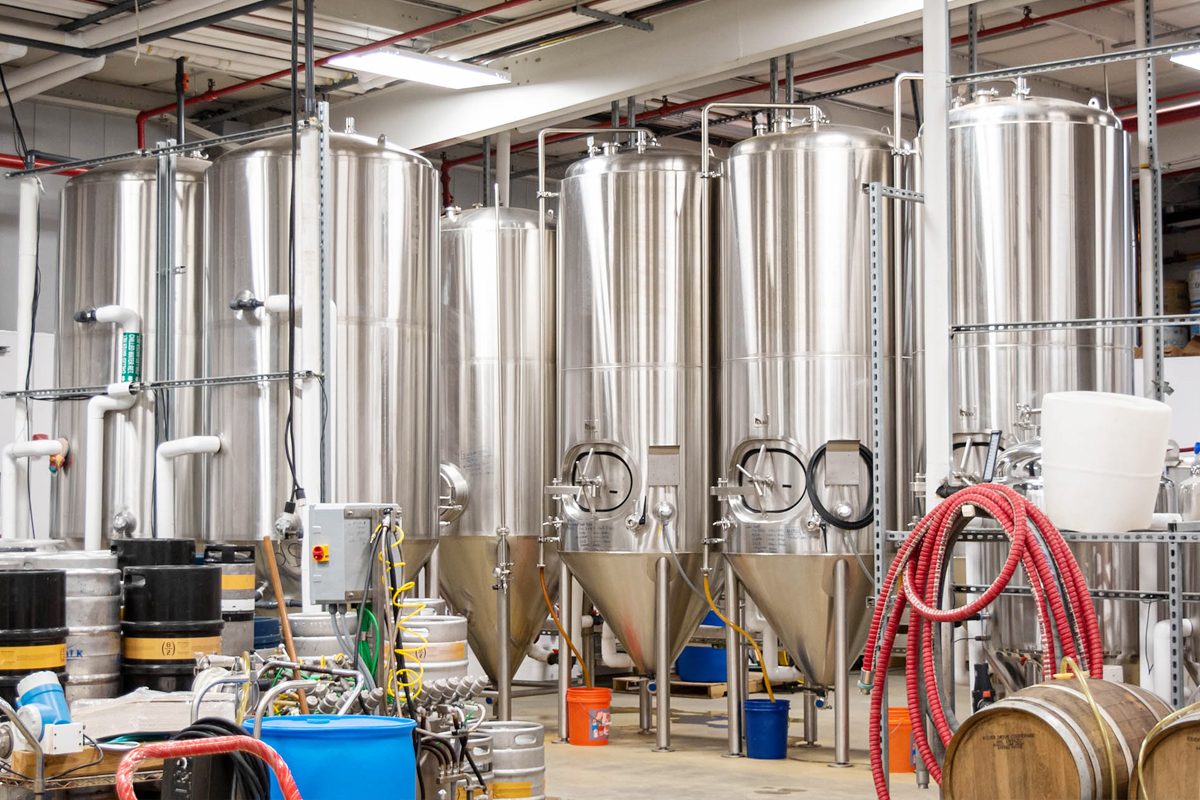
Branding and Aesthetic Considerations
Visual Appeal in Public Spaces
For breweries that welcome visitors, the aesthetic of fermentation tanks can enhance the overall experience. Shiny, well-polished tanks create an impression of professionalism and cleanliness, adding to the brewery’s brand image.
- Polished Stainless Steel: Many breweries opt for polished stainless steel tanks, which have a sleek, modern appearance. Not only do polished tanks look impressive, but they also reflect cleanliness and precision, qualities that are important to both visitors and customers.
- Custom Finishes: Some breweries take aesthetics a step further by applying custom finishes, such as brushed stainless steel or painted exteriors, to match their brand’s color scheme or style. This attention to design detail can elevate the brewery’s overall look, making it more visually engaging for customers and enhancing brand perception.
Logo Placement and Customization
Customizing fermentation tanks with the brewery’s logo or branding can further strengthen brand identity and create a cohesive look throughout the production area. Many breweries choose to display their logo prominently on their tanks, especially in areas where the public can see the brewing equipment.
- Laser Engraving or Decals: Logos and other brand imagery can be laser-engraved directly onto the tank’s surface or applied as high-quality decals. This personalization helps reinforce the brewery’s brand and makes the fermentation tanks an integral part of the brewery’s visual storytelling.
- Consistent Branding: Displaying consistent branding across all tanks and other brewing equipment helps create a unified, professional appearance, enhancing the brewery’s visual identity. This is especially important for breweries that use their production space as part of their marketing efforts.
Design Features for Tasting Rooms and Tours
For breweries that host tours or have open production spaces visible from tasting rooms, the design of fermentation tanks can influence how customers perceive the brewing process.
- Open Sightlines: Tanks designed with clear sightlines can allow visitors to see inside or around the tanks, offering a more immersive experience. Transparent sections, glass manways, or strategically placed lighting can highlight the brewing process, making it more engaging for guests.
- Interactive Experiences: Some breweries take the aesthetic appeal further by incorporating interactive elements, such as tanks with glass panels or displays showing real-time fermentation data. This not only educates visitors but also enhances their connection to the brewing process, creating a memorable experience.
Brand Story and Unique Aesthetic Choices
The aesthetic of the fermentation tanks can also reflect a brewery’s unique story, heritage, or production philosophy. For example, a brewery focused on traditional brewing methods might choose tanks with a vintage or rustic look to evoke an old-world feel, while a modern, high-tech brewery might opt for sleek, minimalist tanks that highlight cutting-edge technology.
- Custom Shapes or Designs: For breweries that want to stand out, custom-shaped fermentation tanks or tanks with unique design elements can become a visual centerpiece. These tanks can be tailored to reflect the brand’s identity and can even be used as part of marketing materials, photographs, or social media content.
- Historical or Thematic Designs: Breweries with a historical theme or connection to a specific cultural heritage might choose fermentation tanks designed to evoke a particular era or brewing style. For instance, copper or wooden elements can give a tank a more traditional, craft-inspired appearance, aligning with the brewery’s brand values.
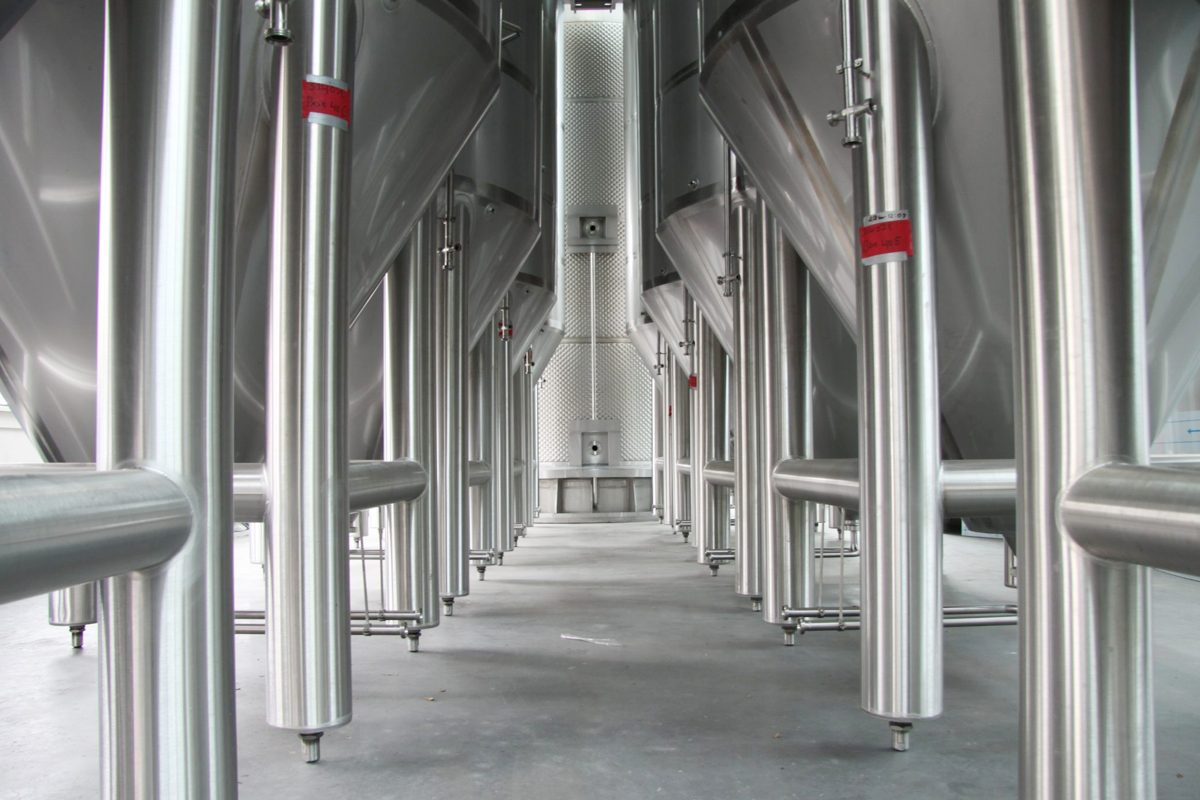
Cost Considerations
Initial Purchase Costs
The upfront cost of fermentation tanks can vary widely depending on factors like size, material, design, and additional features. While smaller tanks for microbreweries or pilot systems may be relatively affordable, larger, custom-built tanks with advanced features can represent a significant investment.
- Tank Size and Volume: Larger fermentation tanks are naturally more expensive due to the increased material and construction costs. However, investing in a larger tank upfront may save costs in the long term by allowing for greater production capacity and fewer brewing cycles.
- Material and Quality: Tanks made from high-quality materials, such as 316 stainless steel, will cost more than lower-grade materials like plastic or standard steel. Although more expensive, high-quality materials are more durable, easier to maintain, and provide better resistance to corrosion and contamination, ensuring longevity.
- Customization: Custom features like additional ports, unique shapes, or specific branding elements can add to the initial cost. While these features enhance functionality and aesthetics, breweries should carefully assess whether these customizations provide tangible value for their specific production process.
Operational Costs
Beyond the initial purchase, operational costs play a significant role in determining the long-term affordability of fermentation tanks. Operational costs include energy consumption, cleaning and maintenance, and labor.
- Energy Efficiency: Tanks equipped with efficient cooling systems or high-quality insulation help reduce energy costs by maintaining stable fermentation temperatures with minimal energy input. Although these features might increase the initial price, the energy savings over time can more than makeup for the difference.
- Maintenance and Repairs: Investing in a well-built, durable tank can reduce the need for costly repairs or frequent maintenance. Tanks with smooth, polished interiors are easier to clean and less prone to harboring bacteria or residue, lowering the cost of cleaning solutions and labor. Additionally, tanks made from durable materials like 316 stainless steel are less likely to suffer from corrosion or damage, further reducing maintenance costs.
- Labor Costs: Tanks with automated systems, such as Clean-In-Place (CIP) setups or automated temperature control, can reduce the need for manual labor, lowering overall operational expenses. By automating certain processes, brewers can focus their attention on other aspects of production, improving efficiency.
Scalability and Future Growth
When selecting fermentation tanks, it’s important to consider how your brewery might grow in the future. Investing in tanks that can scale with your production needs can save significant costs down the line, preventing the need for expensive equipment replacements or upgrades.
- Modular Tanks: Modular or expandable tanks allow breweries to add capacity incrementally as production scales up. Although these systems may have a higher initial cost, they offer flexibility for future growth, preventing the need to overhaul the entire brewing setup when demand increases.
- Long-Term Investment: Investing in larger tanks or more advanced systems upfront may seem costly, but it can provide a better return on investment by supporting higher production volumes, reducing operational inefficiencies, and minimizing the need for frequent upgrades or expansions.
Return on Investment (ROI)
When evaluating the cost of fermentation tanks, it’s essential to look beyond the initial price and assess the long-term return on investment. A higher upfront cost can be justified if the tank improves production efficiency, reduces waste, or helps the brewery meet higher production targets.
- Production Efficiency: Tanks that streamline the fermentation process or allow for more precise temperature and pressure control can enhance the quality of the beer while reducing energy and labor costs. This improved efficiency often leads to higher yields and less downtime, increasing profitability.
- Quality and Consistency: Investing in high-quality tanks ensures consistent fermentation conditions, leading to better product quality and fewer batch variations. Consistent, high-quality beer increases customer satisfaction and can lead to stronger brand loyalty, which positively impacts sales.
Financing Options
For breweries concerned about the upfront cost of fermentation tanks, financing options or leasing programs may offer a solution. Some tank providers offer payment plans or leasing agreements that allow breweries to spread the cost over time, making it easier to manage the investment while maintaining cash flow.
- Leasing vs. Buying: While leasing can reduce initial expenses, it may end up costing more over time compared to buying. Breweries should carefully evaluate their financial situation and long-term production needs to determine whether purchasing or leasing is the more cost-effective option.
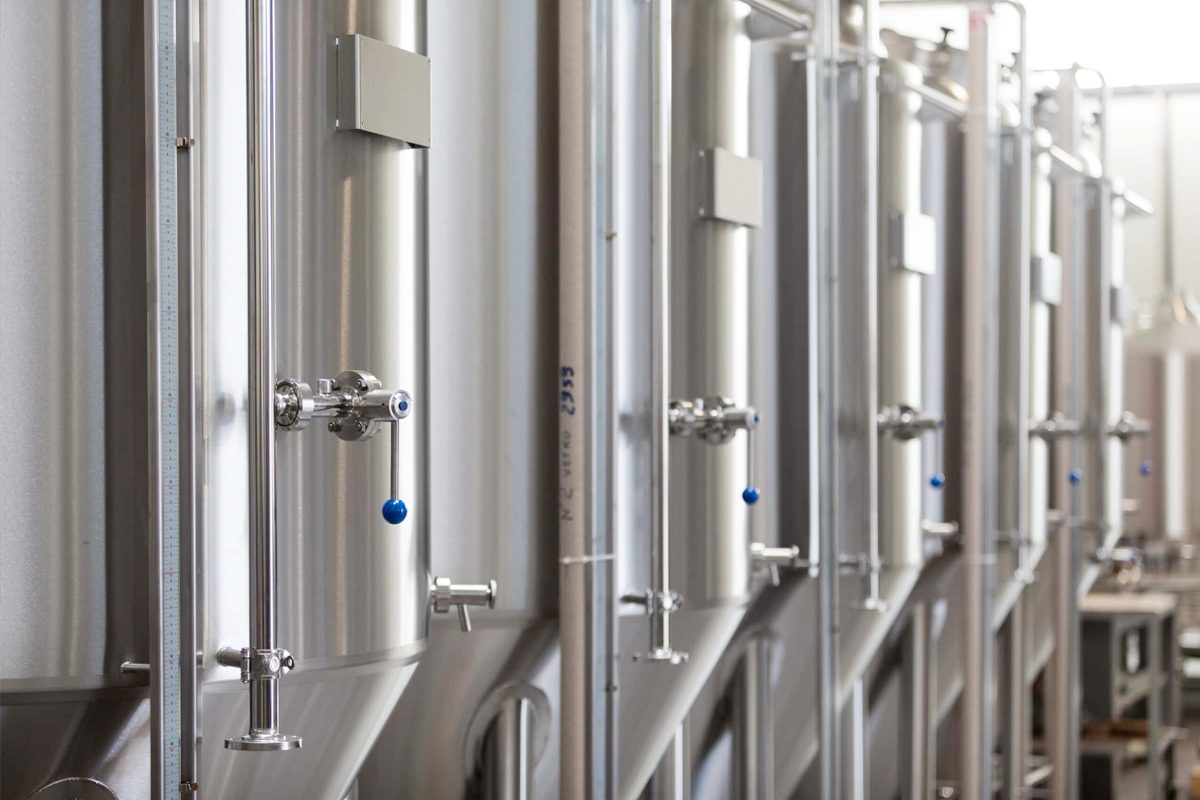
Turnkey Solutions and Supplier Support
Benefits of Turnkey Solutions
Turnkey fermentation systems are designed to simplify the purchasing and installation process by providing all the necessary components and services in one comprehensive package. This approach minimizes the complexity of sourcing different parts from multiple vendors and ensures that all components are fully compatible and ready for use.
- Comprehensive Package: With turnkey solutions, breweries receive everything they need to get started, including fermentation tanks, piping, control systems, and cooling units. This comprehensive package eliminates the need for additional purchases and ensures a seamless integration of equipment.
- Ease of Installation: A turnkey solution includes professional installation services, reducing the risk of errors during setup. Experienced technicians from the supplier handle the installation, ensuring that the tanks are properly connected and fully functional from day one.
- Reduced Downtime: Because the tanks and all necessary components are delivered as a ready-to-use system, breweries can avoid the delays and complications often associated with piecemeal installations. This allows the brewery to quickly ramp up production and meet operational timelines.
Supplier Expertise and Pre-Sales Consultation
One of the key advantages of working with a supplier that provides turnkey solutions is the access to industry expertise during the pre-sales phase. An experienced supplier can assess your brewery’s unique needs and recommend the most appropriate fermentation tanks based on production capacity, space constraints, and future growth plans.
- Customized Solutions: Instead of offering a one-size-fits-all product, many suppliers will tailor their fermentation tank solutions to your brewery’s specifications. This includes selecting the right tank size, material, and configuration to optimize production efficiency.
- Facility Assessment: Pre-sales support often involves a thorough assessment of your brewery’s existing infrastructure. Suppliers can evaluate space limitations, existing equipment, and process requirements to ensure that the fermentation tanks integrate seamlessly with your brewing operation.
- Project Planning: The supplier can also help with project planning, including timelines for delivery, installation, and commissioning, ensuring that the tanks are installed on schedule and within budget.
Ongoing Technical Support
After installation, having access to ongoing technical support from the supplier is critical for maintaining the performance and longevity of your fermentation tanks. From troubleshooting operational issues to providing routine maintenance, a reliable supplier offers the support necessary to keep your brewery running smoothly.
- Training and Maintenance Support: Many suppliers offer training for brewery staff on how to operate and maintain the tanks. This training ensures that your team understands the equipment and can perform routine maintenance tasks to prevent downtime and extend the life of the tanks.
- Troubleshooting and Repairs: In the event of a malfunction or operational issue, having access to expert troubleshooting and repair services from the supplier can minimize production delays. Many suppliers offer remote support as well as on-site service to address any technical problems quickly.
- Spare Parts Availability: A good supplier will also provide easy access to spare parts for the tanks, ensuring that any worn-out or damaged components can be replaced promptly. This helps reduce downtime and keeps the brewery’s production schedule on track.
Long-Term Partnership
Choosing a supplier that provides turnkey solutions and ongoing support fosters a long-term partnership that can benefit the brewery as it grows. As your production needs evolve, the supplier can offer guidance on upgrading or expanding your fermentation tank system, ensuring that the equipment continues to meet your requirements over time.
- Scalability: A supplier with deep industry expertise can help plan for future expansion by recommending scalable fermentation tank systems that allow for increased production capacity as the brewery grows. This forward-thinking approach ensures that the equipment you invest in today will continue to serve your needs in the years ahead.
- Continuous Improvement: As new brewing technologies emerge, your supplier can provide updates or enhancements to your existing fermentation tank system, keeping your brewery at the forefront of innovation and efficiency.
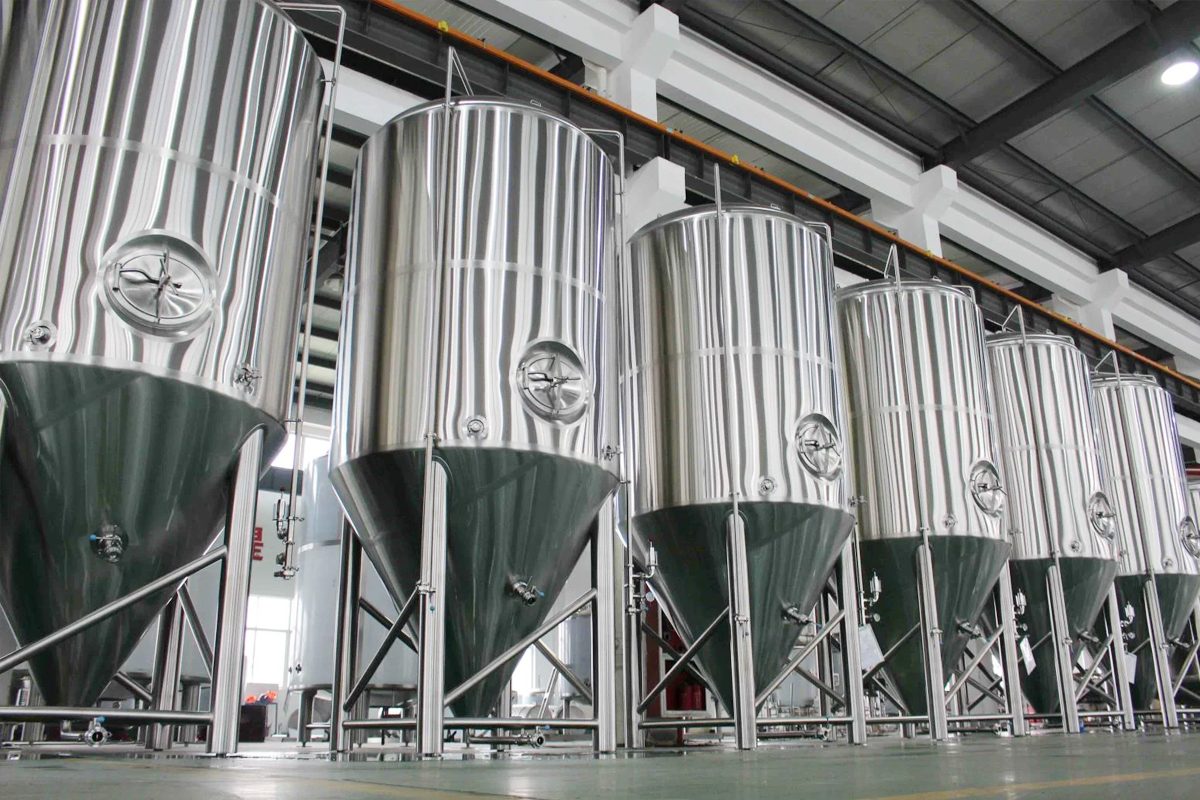
Summary
